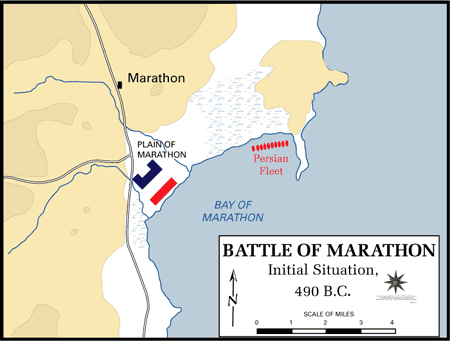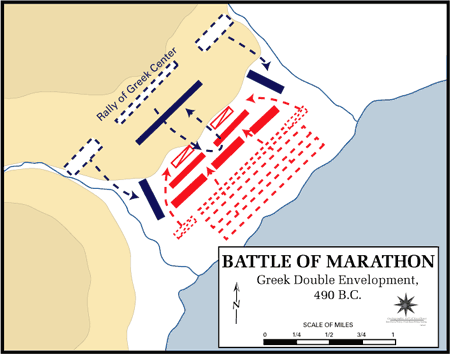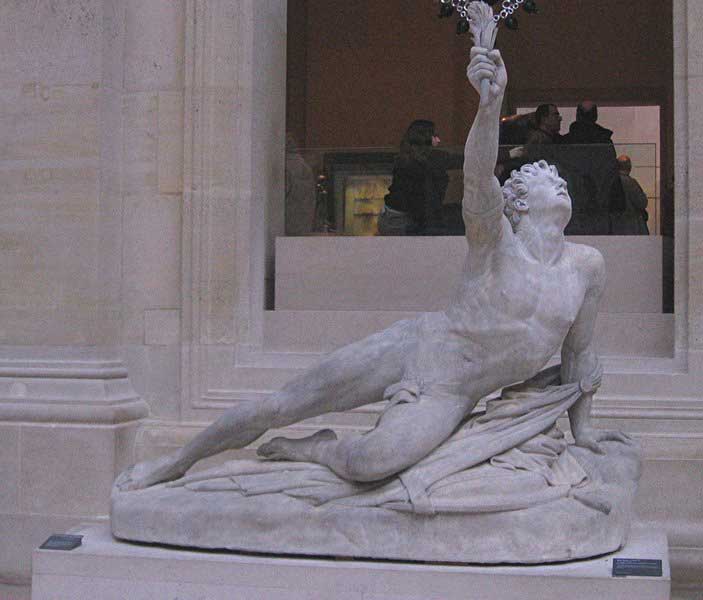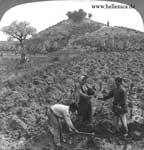.
.. As you go to the portico which they call painted, because of its pictures, there is a bronze statue of Hermes of the Market-place, and near it a gate.... At the end of the painting are those who fought at Marathon; the Boeotians of Plataea and the Attic contingent are coming to blows with the foreigners. In this place neither side has the better, but the center of the fighting shows the foreigners in flight and pushing one another into the morass, while at the end of the painting are the Phoenician ships, and the Greeks killing the foreigners who are scrambling into them. Here is also a portrait of the hero Marathon, after whom the plain is named, of Theseus represented as coming up from the under-world, of Athena and of Heracles. The Marathonians, according to their own account, were the first to regard Heracles as a god. Of the fighters the most conspicuous figures in the painting are Callimachus, who had been elected commander-in-chief by the Athenians, Miltiades, one of the generals, and a hero called Echetlus, of whom I shall make mention later. Pausanias
The Battle of Marathon (490 BC) was the culmination of King Darius I of Persia's first major attempt to conquer the remainder of the Greeks and add them to the Persian Empire, thereby securing the weakest portion of his Western border.
Background
Hippias, tyrant of Athens, had been expelled in 510 BC by his people, with the assistance of Cleomenes I, King of Sparta. He fled to the court of Darius to seek assistance.
With the failure of the Ionian Revolt (499 BC - 494 BC), Darius was intent on subjugating the Greeks and punishing them for their part in the revolt. In 492 BC Darius dispatched an army under his son-in-law, Mardonius. This army reduced Thrace and compelled Alexander I of Macedon to submit again to Persia. However, in attempting to advance into Greece much of the fleet was wrecked in a storm and Mardonius was forced to retreat to Asia.
Darius learned through Hippias that the Alcmaeonidae, a powerful Athenian family, were opposed to Miltiades and ready to help reinstate Hippias. They were also ready to bow to Persian demands in exchange for being excused for their role in the Ionian Revolt. Darius wished to take advantage of this situation to take Athens, which would isolate Sparta and hand him the remainder of the Greeks. In order for the Athenians to revolt, two things would need to happen: the populace would need encouragement to revolt, and the Athenian army would have to leave Athens.
In order to accomplish the first, Darius planned to take Eretria, which would offer little resistance, and whose fall would terrify the Athenians. To accomplish the second, Darius's army, now led by Artaphernes, son of a satrap of Sardis, and Datis, a Median admiral (Mardonius had been injured in the prior attack), was dispatched in early September 490 BC to land at the Bay of Marathon and threaten an overland attack towards Athens. This army probably numbered at most 25,000 infantry and 1,000 cavalry, since it was transported entirely by sea.
The Persian transports, escorted by the fleet, sailed from Samos to Naxos and reached Carystus on the south coast of Euboea. From there they sailed up the Euboean channel to Eretria, where their aims became clear to the Greeks.
The Eretrians sent an urgent message to Athens for help. The Athenians agreed, but realized they needed more help. They sent a courier to the Spartans and probably a messenger to the Plataeans. The courier arrived in Sparta on September 9, and the Spartans agreed to help, but pointed out that they could not go to war until the Carneian festival ended on the full moon of September 19-20.

Marathon from Space
Artaphernes took part of the Persian army and laid siege to Eretria. The remainder of the army crossed with Datis and landed in the Bay of Marathon. The Athenian army, numbering 9,000-10,000, under Callimachus the polemarch and accompanied by his ten tribal generals marched north from Athens. When Callimachus heard that the Persians had landed in the Bay of Marathon, he wheeled right and reached the valley of Avlona and encamped his army at the shrine of Heracles. One thousand Plataeans joined him there.
Since it was obvious from the Persians' disposition that they did not intend to march to Athens, the Athenians waited for the Spartans. For eight days the armies peacefully confronted each other.
Battle


On the ninth day it became known to the Athenians that Eretria had fallen by treachery. This meant that Artaphernes was now free to move, and might attack Athens. On September 21, the Athenian army went out to face the Persians. This was probably a combined decision by the generals, although Herodotus reports that they were rotating days of command and that Miltiades was in charge at this point, since he had a large part in persuading the others to do so. According to Herodotus, five Strategoi voted for the move and five voted against it, with Callimachus, the Polemarch, casting the deciding vote in favor of attack.
Since the bulk of Persian infantry were archers, the Greek plan was to advance in formation until they reached the limit of the archer's effectiveness, the "beaten zone," or roughly 200 yards, then advance in double time to close ranks quickly and bring their heavy infantry into play. This meant that they would almost certainly end up fighting in disordered ranks, but this was preferable to giving the Persian archers more time. The Greek center was reduced to possibly four ranks, from the normal eight, in order to extend the line and prevent the Persian line from overlapping the Greeks. The wings maintained their eight ranks.
The Greek heavy infantryman, or hoplite, was much more heavily armored than the Persian troops and the pike the Greeks carried gave them greater range than the short spears and swords of the Persian foot soldier. The Persian advantage came from the bow that most of them carried (the advantage was partially cancelled by the superiority of Greek armor and numbers).
As the Greeks advanced, their wings drew ahead of the center, which was under heavy fire from the archers. As they closed some Persians broke through the resulting gaps and drove the center back in rout. The Greek retreat in the center, besides pulling the Persians in, also brought the Greek wings inwards, shortening the Greek line. The inadvertent result was a double envelopment, and the battle ended when the whole Persian army, crowded into confusion, broke back in panic towards their ships and were pursued by the Greeks.
Herodotus records that 6,400 Persians died for the loss of approximately 192 Athenians.
Aftermath
As soon as Datis had put to sea, the Athenians marched to Athens. They arrived in time to prevent Artaphernes from securing a landing. Seeing his opportunity lost, Artaphernes set about and returned to Asia. The Spartans arrived afterwards, toured the battlefield at Marathon, and agreed that the Athenians had won a great victory.
The Greek upset of the Persians, who had not been defeated on land for many decades, caused great problems for the Persians. Seeing that the Persians were not invincible, many peoples subject to their rule rose up following the defeat of their overlords at Marathon and order was not restored for several years.
The common enemy of Persia helped provide some solidarity to the disunited Greek city-states. The victory helped solidify the view that Greeks were "civilized" and Asians were merely "Barbarians."
Conclusion
Marathon was in no sense a decisive victory over the Persians. However, it was the first time the Greeks had bested the Persians on land, and "their victory endowed the Greeks with a faith in their destiny which was to endure for three centuries, during which western culture was born." (J.F.C. Fuller, A Military History of the Western World.) In this Fuller echoes John Stuart Mill's famous opinion that the Battle of Marathon was more important an event for British history than the Battle of Hastings.

The soldier of Marathon, Luc-Olivier Merson, 1869
According to the Greek historian Herodotus, who was born in the year of the battle, an Athenian soldier named Pheidippides ran from Athens to Sparta to ask for assistance. This event was later turned into the popular legend that Pheidippides ran from Marathon to Athens. The International Olympic Committee estimates the distance from the Marathon battlefield to Athens as 34.5 km (21.4 miles). There is no historical evidence for this popular version of the legend, which first appears in Plutarch's On the Glory of Athens in the 1st century AD. The story became the basis for the modern marathon athletics event. The race is run over a distance of 42.195 km (26.2 miles).
|
Battle of Marathon |
||
|---|---|---|
|
Conflict |
Persian Wars |
|
|
Date |
September, 490 BC |
|
|
Place |
Marathon, Greece |
|
|
Result |
Greek victory |
|
|
Combatants |
||
|
Greek city-states |
Persia |
|
|
Commanders |
||
|
|
|
|
Strength |
||
|
About 10,000 |
No more than 20,000 (26,000 according to Herodotus) Persians organized in Hazarabam ( 1000 men) and Baivarabam Units (10000 men) |
|
|
Casualties |
||
|
192 dead |
About 6,400 dead |
|
|
|
||
|
Battle before |
Battle after |
|
.Before turning to a description of the islands, I must again proceed with my account of the parishes. There is a parish called Marathon, equally distant from Athens and Carystus in Euboea. It was at this point in Attica that the foreigners landed, were defeated in battle, and lost some of their vessels as they were putting off from the land. On the plain is the grave of the Athenians, and upon it are slabs giving the names of the killed according to their tribes; and there is another grave for the Boeotian Plataeans and for the slaves, for slaves fought then for the first time by the side of their masters.
Here is also a separate monument to one man, Miltiades, the son of Cimon, although his end came later, after he had failed to take Paros and for this reason had been brought to trial by the Athenians. ....
They say too that there chanced to be present in the battle a man of rustic appearance and dress. Having slaughtered many of the foreigners with a plough he was seen no more after the engagement. When the Athenians made enquiries at the oracle the god merely ordered them to honor Echetlaeus (He of the Plough-tail) as a hero. A trophy too of white marble has been erected. Although the Athenians assert that they buried the Persians, because in every case the divine law applies that a corpse should be laid under the earth, yet I could find no grave. There was neither mound nor other trace to be seen, as the dead were carried to a trench and thrown in anyhow. Pausanias

At Marathon for Greece the Athenians fought ;
And low the gilded Medians' power they brought. Simonides

Jean-Pierre CORTOT, The soldier of Marathon announces the victory, 1822-1834 [Source]
Peter Green , The Greco-Persian Wars- , University of California Press; Reprint edition (August, 1998) ISBN: 0520203135

Cynaegeirus, brother of Aeschylus
| Ancient Greece
Science, Technology , Medicine , Warfare, , Biographies , Life , Cities/Places/Maps , Arts , Literature , Philosophy ,Olympics, Mythology , History , Images Medieval Greece / Byzantine Empire Science, Technology, Arts, , Warfare , Literature, Biographies, Icons, History Modern Greece Cities, Islands, Regions, Fauna/Flora ,Biographies , History , Warfare, Science/Technology, Literature, Music , Arts , Film/Actors , Sport , Fashion --- |
Retrieved from "http://en.wikipedia.org"
All text is available under the terms of the GNU Free Documentation License


